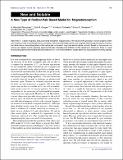Files in this item
A New Type of Radical-Pair-Based Model for Magnetoreception
Item metadata
| dc.contributor.author | Stoneham, A. Marshall | |
| dc.contributor.author | Gauger, Erik M. | |
| dc.contributor.author | Porfyrakis, Kyriakos | |
| dc.contributor.author | Benjamin, Simon C. | |
| dc.contributor.author | Lovett, Brendon W. | |
| dc.date.accessioned | 2014-08-20T16:01:01Z | |
| dc.date.available | 2014-08-20T16:01:01Z | |
| dc.date.issued | 2012-03-07 | |
| dc.identifier | 79638933 | |
| dc.identifier | ceb76326-939d-4d75-8460-d22110bf81c1 | |
| dc.identifier | 000301280900002 | |
| dc.identifier | 84858052911 | |
| dc.identifier.citation | Stoneham , A M , Gauger , E M , Porfyrakis , K , Benjamin , S C & Lovett , B W 2012 , ' A New Type of Radical-Pair-Based Model for Magnetoreception ' , Biophysical Journal , vol. 102 , no. 5 , pp. 961-968 . https://doi.org/10.1016/j.bpj.2012.01.007 | en |
| dc.identifier.issn | 0006-3495 | |
| dc.identifier.other | ORCID: /0000-0001-5142-9585/work/47136549 | |
| dc.identifier.uri | https://hdl.handle.net/10023/5202 | |
| dc.description | This work was supported by the National Research Foundation and Ministry of Education, Singapore; the Engineering & Physical Sciences Research Council (UK); and the Quantum Information Processing Interdisciplinary Research Collaboration (grant No. GR/S82176/01). B.W.L. thanks the Royal Society for a University Research Fellowship. | en |
| dc.description.abstract | Certain migratory birds can sense the Earth's magnetic field. The nature of this process is not yet properly understood. Hereweoffer a simple explanation according to which birds literally see the local magnetic field through the impact of a physical rather than a chemical signature of the radical pair: a transient, long-lived electric dipole moment. Based on this premise, our picture can explain recent surprising experimental data indicating long lifetimes for the radical pair. Moreover, there is a clear evolutionary path toward this field-sensing mechanism: it is an enhancement of a weak effect that may be present in many species. | |
| dc.format.extent | 8 | |
| dc.format.extent | 764748 | |
| dc.language.iso | eng | |
| dc.relation.ispartof | Biophysical Journal | en |
| dc.subject | Photoreceptor-based magnetoreception | en |
| dc.subject | Magnetic compass orientation | en |
| dc.subject | Electric-field | en |
| dc.subject | Chemical magnetoreception | en |
| dc.subject | Bacteriorhodopsin BR570 | en |
| dc.subject | Avian magnetoreception | en |
| dc.subject | Migratory birds | en |
| dc.subject | Homing pigeons | en |
| dc.subject | DNA photolyase | en |
| dc.subject | Mechanism | en |
| dc.subject | QC Physics | en |
| dc.subject.lcc | QC | en |
| dc.title | A New Type of Radical-Pair-Based Model for Magnetoreception | en |
| dc.type | Journal item | en |
| dc.contributor.institution | University of St Andrews. School of Physics and Astronomy | en |
| dc.contributor.institution | University of St Andrews. Condensed Matter Physics | en |
| dc.identifier.doi | https://doi.org/10.1016/j.bpj.2012.01.007 | |
| dc.description.status | Peer reviewed | en |
This item appears in the following Collection(s)
Items in the St Andrews Research Repository are protected by copyright, with all rights reserved, unless otherwise indicated.

